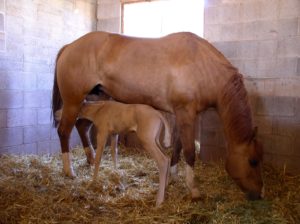
Retained placenta or retained foetal membranes is a common condition in horses after giving birth. It occurs when the mare’s placenta does not fully detach from the uterus. This can happen for various reasons such as hormonal imbalances, infections, or even stress. If left untreated, it can lead to serious complications such as uterine infections, laminitis, or even death.
If you notice that your mare’s placenta is still hanging out after giving birth, it is important to call a vet immediately. The vet will examine your mare and may perform a manual removal of the placenta or prescribe medication to help it detach naturally. It is important to act quickly to ensure the health and safety of your mare.
In some cases the placenta may be retained and not visible from the outside so ALWAYS check to make sure you can see the placenta on the ground when the foal is born. Often people get caught up in the excitement of a new foal that they forget to check these things. It is always advisable to get your vet to check the placenta after foaling to check the health of the placenta as this not only gives some idea of the health of your foal, but also the mother. It is also a great opportunity to make sure the entire placenta has been removed as sometimes a tip of the placenta can remain.
Why is the mare’s placenta still hanging out after giving birth?
As a horse owner, it can be alarming to see your mare’s placenta still hanging out after giving birth. While this does not happen to every mare, it can happen and it’s important to understand why and what to do about it.
Possible reasons for retained placenta
There are several reasons why a mare’s placenta may not fully detach after giving birth:
- Incomplete delivery: Sometimes, the placenta may not fully detach from the uterus during delivery, leading to a retained placenta.
- Infection: Infections in the uterus can cause inflammation and prevent the placenta from detaching properly.
- Hormonal imbalances: Hormonal imbalances can also affect the detachment of the placenta.
- The foal hasn’t latched and nursed yet. The nursing of the foal releases a natural hormone that allows uterine contractions to remove the membranes and fluids left after foaling.
- Stress: Stressful situations, such as a difficult birth or transportation, can also contribute to a retained placenta. Maiden mares can sometimes stress more than mares that have had a foal and will fuss over the foal, or stress because she is in pain
It’s important to note that a retained placenta can lead to serious complications such as infection, inflammation, laminitis and even death. Therefore, it’s crucial to seek veterinary attention as soon as possible.
If you notice that your mare’s placenta is still hanging out after giving birth, do not attempt to remove it yourself. Instead, call your veterinarian immediately. They will be able to assess the situation and determine the best course of action. One thing you can do while the vet is arriving is tie a weight to the placenta to help the mare release the placenta. To do this you can get a plastic container such as a softdrink bottle no more than 2 litres in size and half fill with water. Use some string or twine to tie to the placenta. This allows more weight and hopefully it may pass while the vet is coming. ALWAYS keep the placenta to let the vet examine to make sure it has all been removed.
What are the risks of a retained placenta?
Potential Complications
When a mare retains her placenta after giving birth, it can lead to a number of potential complications. If left untreated, a retained placenta can cause serious health issues for the mare, including:
- Uterine infections: When the placenta remains in the uterus, it can cause infections to develop. These infections can lead to a variety of symptoms, including fever, lethargy, and loss of appetite. In severe cases, they can even be life-threatening.
- Endotoxemia: Endotoxemia occurs when toxins from bacteria in the mare’s uterus enter her bloodstream. This can cause a range of symptoms, including fever, diarrhea, laminitis and colic. In severe cases, it can lead to shock and even death.
- Metritis: Metritis is a severe infection of the uterus that can occur when the placenta is retained. It can cause a range of symptoms, including fever, lethargy, and loss of appetite. If left untreated, it can be life-threatening.
- Uterine tearing: often caused by owners removing the placenta themselves. This can lead to death if not diagnosed quickly.
If you suspect that your mare has retained her placenta, it is important to contact your veterinarian immediately. They can perform an examination to determine the cause of the retention and provide appropriate treatment.
What is the treatment for retained placenta?
Medical treatment options
If your mare has retained placenta, it is important to call your veterinarian as soon as possible. Your vet may choose to administer oxytocin, a hormone that can help stimulate uterine contractions and expel the placenta. In some cases, antibiotics may also be prescribed to prevent infection.
Another medical treatment option is the use of prostaglandins, which can help relax the cervix and promote placental expulsion. However, this treatment should only be used under the guidance of a veterinarian, as it can also cause uterine contractions and may lead to complications if not used properly.
Surgical treatment options
In some cases, surgical intervention may be necessary to remove the retained placenta. This is typically done under general anesthesia, and involves manually removing the placenta from the uterus. Your vet may also choose to administer antibiotics to prevent infection.
In rare cases, a partial or complete hysterectomy may be necessary if the placenta cannot be safely removed. This is a major surgical procedure, and should only be considered as a last resort.
When Should You Call a Vet?
Signs to Look Out For
If your mare has given birth and her placenta is still hanging out of her, it is important to monitor her closely for any signs of distress or complications. Some signs to look out for include:
- Excessive bleeding
- Foul-smelling discharge
- Difficulty standing or walking
- Loss of appetite
- Lethargy or weakness
If you notice any of these signs, it is important to call your veterinarian immediately. Moreso, if you can’t find the placenta after birth it is important to call the vet as sometimes it is not visible from the outside that the placenta is still attached.
When to Seek Emergency Veterinary Care
In some cases, a retained placenta can lead to serious complications that require emergency veterinary care. If your mare is exhibiting any of the following signs, you should seek veterinary care immediately:
- Severe bleeding
- Severe abdominal pain
- Difficulty breathing
- Seizures or convulsions
If you are unsure whether your mare needs emergency care, it is always better to err on the side of caution and call your veterinarian. Remember, a retained placenta can be a serious condition that requires prompt veterinary care. By monitoring your mare closely and seeking veterinary care when necessary, you can help ensure a successful recovery.



